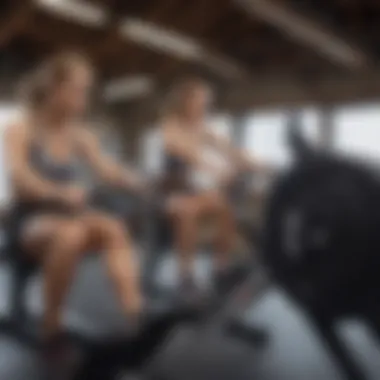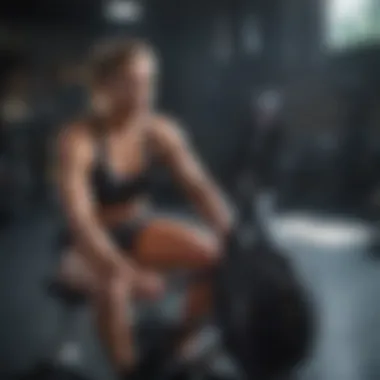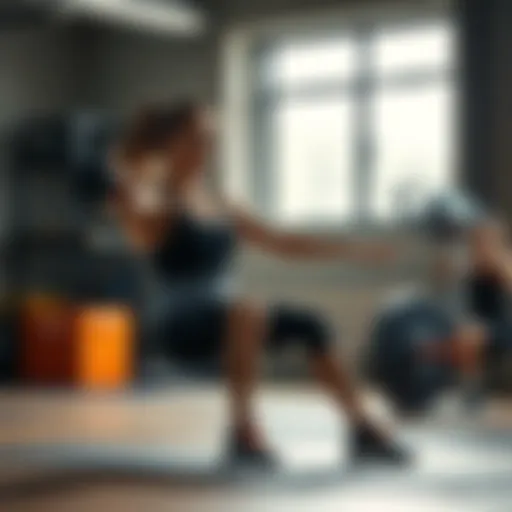Maximizing Performance with the Rower-SkiErg Combo


Intro
Integrating the rower and SkiErg into fitness routines can remarkably enhance performance across various dimensions of physical health. Athletes and fitness seekers alike are appreciating the unique benefits these two machines provide. The rower emphasizes total body engagement, while the SkiErg focuses on upper body strength and endurance, ensuring that users achieve a comprehensive workout. This section paves the way for a deeper understanding of how these modalities can be combined for optimal results.
Wellness Insights
Benefits of Regular Exercise
Regular exercise has profound effects, not just on physical appearance but on overall well-being. Engaging in workouts that combine rowing and SkiErg promotes cardiovascular health, improves muscle strength, and boosts endurance levels. These machines are particularly effective for enhancing aerobic capacity and stamina. Furthermore, a consistent routine can facilitate weight management and elevate mood, thanks to the release of endorphins.
Understanding Mental Health
Exercise also plays a crucial role in mental health. Engaging with both a rower and SkiErg can alleviate symptoms of anxiety and depression. The rhythm of movement and attention to breathing allows for a meditative state, reducing stress and fostering mindfulness. When integrating these machines, practitioners experience not only physical challenges but also mental clarity and resilience.
Mechanics of Rowing and SkiErg
Rowing Mechanics
Rowing engages multiple muscle groups. The legs initiate the power, while the back and arms contribute to the pull. The act of rowing demands coordination and rhythm, which is integral for maximizing power output. It's recommended to focus on proper form to prevent injuries and enhance efficiency.
SkiErg Mechanics
The SkiErg offers a different emphasis. Primarily targeting the upper body, it promotes strength in the arms, shoulders, and core. The motion mimics cross-country skiing, providing a unique workout that doesn't put excess strain on the lower body. Fine-tuning technique is essential, especially regarding posture and core engagement.
Combining Rower and SkiErg
These two machines complement each other in various ways. Having both in a training regimen allows for balanced development. The rowing motion builds lower body strength and endurance, while the SkiErg enhances upper body power. Alternating between machines can prevent fatigue and maintain workout motivation.
Practical Advice for Integration
- Start with Warm-ups: Engage in light activities to prepare muscles before alternating between machines.
- Set Clear Goals: Define your objectives. Decide whether to focus on endurance, strength, or recovery.
- Develop a Schedule: Create a balanced workout schedule. Combining machines two to three times a week can yield significant improvements.
- Monitor Progress: Assess endurance and strength gains regularly to make informed adjustments to the routine.
Ending
By understanding the synergies between rowing and SkiErg, practitioners can cultivate a comprehensive fitness approach. Each machine contributes uniquely, enhancing cardiovascular capacity, strength, and recovery. Adopting a routine that incorporates both modalities will likely result in a well-rounded, effective fitness journey.
Understanding the Rower-SkiErg Combo
To grasp the full potential of integrating a rower and SkiErg, it is essential to understand how these machines operate and the benefits they bring to fitness routines. Both modalities enhance not only physical health but also overall athletic performance. This section will explore the mechanics of each machine, their respective advantages, and the synergistic effects that arise when combined in a workout routine.
The Rower: Mechanics and Benefits
Rowing machines mimic the action of rowing a boat and engage multiple muscle groups. The mechanics primarily involve pulling a handle attached to a chain or strap while seated on a gliding seat. This movement engages the legs, back, and arms, offering a full-body workout.
Benefits of rowing include:
- Cardiovascular fitness: Rowing elevates the heart rate, promoting cardiovascular health.
- Muscle strengthening: It primarily targets the legs, back, core, and arms, providing balanced muscle development.
- Low-impact exercise: Suitable for all fitness levels, rowing puts less stress on the joints compared to high-impact workouts.
The SkiErg: Mechanics and Benefits
The SkiErg simulates cross-country skiing motions, focusing on upper body strength as well as core stability. Users alternate pushing and pulling ski handles, in a standing position or seated. This machine promotes endurance and strength development through its unique setup.
Key benefits of the SkiErg include:
- Upper body engagement: It effectively targets the shoulders, arms, chest, and core.
- Improvement in coordination: The alternating motion enhances overall body coordination and balance.
- Caloric burn: SkiErg workouts can lead to high energy expenditure, aiding in weight management.
Complementary Workout Structures
Combining rowing with the SkiErg can create a comprehensive workout regimen. Each machine targets different muscle groups, making it vital to integrate them in a balanced manner. For example, alternating sessions can provide both endurance and strength training benefits.
To maximize efficiency with the Rower and SkiErg combination, consider these structures:
- Circuit training: Alternate between the rower and SkiErg within a single workout.
- Time-based intervals: Use a timer to switch between machines at regular intervals for high-intensity workouts.
- Themed sessions: Focus one session on upper body using the SkiErg, followed by a session emphasizing lower body strength with the rower.
Using the rower and SkiErg in tandem fosters a well-rounded fitness regimen that promotes overall athletic performance.
Integrating these two machines allows for consistent variation in workout routines, which can enhance motivation and adherence. Understanding their mechanics and benefits serves as a foundation for utilizing both machines effectively for optimal performance.
Physiological Impact of Both Machines


Understanding the physiological impact of using both the rower and the SkiErg is essential for anyone aiming to optimize their training. These machines target different muscle groups and energy systems, which can lead to enhanced overall fitness. When used together, they create a balanced workout that maximizes cardiovascular benefits, muscle engagement, and energy expenditure.
Cardiovascular Response
The rower and SkiErg significantly stimulate the cardiovascular system. Both machines engage large muscle groups, demanding increased heart rate and blood flow. This response not only improves heart function but also enhances aerobic capacity.
Using the rower, the legs, back, and arms work in unison. This full-body engagement places a high demand on the heart, leading to improved endurance. Similarly, the SkiErg focuses on the upper body and core. With each pull, the heart pumps efficiently to supply muscles with the necessary oxygen. As a result, incorporating both machines leads to robust cardiovascular conditioning.
"To achieve optimal cardiovascular fitness, utilizing a combination of machines like the rower and SkiErg is highly effective."
Muscle Engagement Patterns
The muscle engagement patterns vary between the rower and SkiErg. The rower primarily targets the posterior chain, including muscles such as the glutes, hamstrings, and upper back. This machine provides a comprehensive workout that emphasizes strength and power, making it valuable for developing overall muscle tone.
On the other hand, the SkiErg focuses more on the upper body, engaging muscles like the lats, triceps, and shoulders. It also promotes core stability as the torso must remain engaged throughout the motion. By alternating between or integrating both machines, users can create a synergy that enhances muscle engagement across the body rather than isolating specific areas.
Energy Expenditure Analysis
Energy expenditure is a crucial aspect when assessing the effectiveness of any workout regimen. Both machines can be tailored to different intensities, allowing for a personalized experience. High-intensity intervals on the rower can burn a significant number of calories, owing to the large muscle groups involved.
Meanwhile, the SkiErg, while perceived as less demanding, still offers a substantial caloric burn, especially when performed at higher speeds. By alternating between the two, individuals can sustain elevated energy levels and maximize calorie burning.
Creating a Balanced Workout Routine
Creating a balanced workout routine is essential in maximizing performance when integrating the rower and SkiErg. The value of a structured approach lies in its ability to engage different muscle groups, enhance cardiovascular fitness, and promote overall endurance. A balanced routine ensures that one does not overly favor one machine over the other, which can lead to muscle imbalances and potential injuries. Both pieces of equipment offer unique benefits, and their combination can lead to synchronized gains in strength and endurance.
Integrating Rower and SkiErg Sessions
When integrating rower and SkiErg sessions, the focus should be on uniformity and progression. One effective method is alternating between the two modalities in a single workout. For instance, using a ratio of 1:1, where equal time is spent on each machine, fosters balanced muscular engagement and avoids fatigue in specific muscle groups. Tailoring these sessions according to personal goals is crucial. A beginner may start with shorter intervals while more experienced individuals might engage in extended periods of vigorous activity.
Furthermore, paying attention to the time spent on each machine can influence recovery. Less overlap allows for better muscle recuperation while still maximizing training volume. The transition between machines can also serve as a mental break that maintains engagement and motivation.
Structuring Interval Workouts
Interval workouts can significantly elevate the effectiveness of training routines involving both the rower and SkiErg. The core idea behind interval training is to alternate between bursts of high-intensity effort and lower-intensity recovery periods. This approach not only improves cardiovascular efficiency but also enhances metabolic rate post-exercise.
A practical way to structure these interval workouts is as follows:
- Warm-up: Begin with a five to ten minutes general warm-up on either machine to prepare the body.
- Intervals:
- Cool Down: End with a five minutes cool-down, alternating at a very low intensity on both machines.
- SkiErg: 30 seconds of high-intensity pulling followed by 1 minute of active recovery at a slower pace.
- Rower: 1 minute of high-intensity rowing followed by 2 minutes of low-intensity pacing.
These workouts can be tailored, combined, and repeated as necessary to keep challenging the body and increasing performance.
Endurance vs. Strength Focus
Balancing endurance and strength training within a routine is critical for optimal performance with the rower and SkiErg. It is necessary to consider individual fitness goals and the specific benefits of each workout.
- Endurance Focus: For enhancing aerobic capacity, longer sessions that emphasize maintaining a steady-state effort on both machines can be implemented. This approach supports cardiovascular adaptation and musculoskeletal endurance. Endurance sessions often involve lower resistance and longer durations.
- Strength Focus: Conversely, if strength gain is the primary objective, sessions can involve higher resistance settings with shorter workout durations. Focus on power output, especially in the leg drive on the rower and arm pulls on the SkiErg, encourages muscle hypertrophy and neuromuscular efficiency.
Technique for Optimal Performance
The integration of proper technique in utilizing both the rower and SkiErg is vital for optimizing performance. Each machine specializes in developing key physical attributes, including strength, endurance, and coordination. Correct technique ensures that these advantages are maximized while minimizing the risk of injury, which is essential for sustained training.
Proper Rowing Form
Effective rowing form involves several critical elements that contribute to an overall better performance. Maintaining a strong posture is fundamental; the back should be straight and the core engaged. The legs drive the motion, followed by the torso and arms in a fluid sequence.
- Start Position: Sit with the feet secured and knees slightly bent.
- Drive Phase: Push through your heels while extending your legs. Simultaneously, lean back slightly from your hips.
- Finish Position: Keep the handle close to your body. Your elbows should be drawn back while your legs are straightened.
- Recovery Phase: Extend your arms and lean forward from your hips while bending your knees again.
Good form helps conserve energy, making workouts more productive.
Correct SkiErg Technique
When using the SkiErg, technique also plays a significant role. The SkiErg mimics the motion of skiing, requiring coordination and rhythm. Proper technique can enhance cardiovascular output while engaging upper body muscles effectively.
- Standing/Seated Position: Maintain a slight lean forward, keeping your body straight.
- Arm Pull: Pull down on the handles using your arms, ensuring they move in a downward motion similar to skiing.
- Leg Activation: Incorporate leg drive by bending and extending your knees during each pull, balancing effort.
- Breath Control: Coordinate your breathing with your strokes. Inhale as you push with your arms and exhale through the pull.
Emphasizing these elements leads to improved timing and enhances overall efficacy in sessions.


Common Mistakes to Avoid
When integrating both machines into a training regimen, several pitfalls can detract from performance and lead to injuries. Being aware of these mistakes can help maintain effective workouts.
- Poor Posture: Slouching or rounding the back can lead to soreness and injuries over time.
- Inconsistent Rhythm: In both rowing and SkiErg workouts, a lack of rhythm can disrupt the flow and lead to fatigue.
- Overexertion: Attempting to increase intensity too quickly may result in strain. Gradually increase resistance or speed.
- Neglecting Warm-up: Not preparing adequately can lead to muscle injuries. Spend at least 5-10 minutes warming up.
Proper technique in both rowing and SkiErg can substantially elevate your fitness game. Consistency and attention to form are key.
Incorporating these techniques and being mindful of common mistakes will not only enhance your performance but also support long-term health and wellbeing.
Recovery Strategies and Considerations
Recovery plays a crucial role in training. It is more than just time off from workouts. Instead, it is an essential component that allows the body to repair, rebuild, and strengthen after intense physical activity. When integrating the Rower and SkiErg, attention to recovery helps individuals maximize benefits from their workouts. Failing to incorporate adequate recovery can impediment progress and increase risk of injury. Hence, understanding recovery strategies becomes paramount for high-level performance.
Importance of Recovery in Training
Recovery is vital for athletes and fitness enthusiasts alike. It allows muscles to recover from micro-tears sustained during exercise. Proper recovery supports muscle growth and enhances overall athletic performance. Inadequate recovery can lead to fatigue and decreased performance. Moreover, ignoring recovery can result in overtraining syndrome, marked by persistent fatigue and diminished capacity. The body needs sufficient time to replace glycogen stores depleted during workouts. Therefore, proper recovery ensures sustained energy levels during future sessions.
- Muscle Repair and Growth: Recovery facilitates muscle adaptation, which is critical after the dual strain of rowing and skiing.
- Prevent Overtraining: Regular recovery sessions can help maintain mental and physical health.
- Enhance Tolerance: Improvement in performance occurs when the body is adequately rested and adapted.
Cross-training Benefits
Incorporating the Rower and SkiErg in a training program creates a cross-training environment that provides diverse benefits. Cross-training reduces the monotony of workouts, engaging different muscle groups while allowing others to rest. The combination aids in enhancing cardiovascular fitness. The diverse movements involved can impede adaptation to specific training modalities, thus eliciting better results. Within a recovery framework, this variety is beneficial.
- Reduced Injury Risk: Switching between machines can decrease poundage on specific joints.
- Improved Skill Transfer: Skills learned on one machine can improve performance on the other, making them complementary.
- Mental Freshness: Engaging in various workouts helps prevent burn-out and keeps training enjoyable.
Injury Prevention Techniques
Implementing injury prevention techniques is vital for athletes using both the Rower and SkiErg. A proactive approach helps maintain long-term training consistency. Strengthening the core and stabilizer muscles may lower the risk of injuries related to improper posture or overuse. Here are some strategies:
- Proper Warm-up and Cool-down: Engaging in adequate stretching before and after workouts can minimize the risk of injury.
- Listen to Your Body: Pain signals from the body must be taken seriously to prevent any further injuries.
- Gradual Progression: Slowly increasing workout intensity helps prevent fatigue and overstraining.
"Proper recovery is the key not just to performance, but overall health. It supports sustainable training practices."
In summary, integrating recovery strategies is essential when using the Rower and SkiErg. Detailed attention to recovery can prevent injuries, enhance performance, and maintain mental well-being for individuals engaged in rigorous training.
By implementing these recovery strategies, athletes can ensure that their training is not only effective but also sustainable in the long term.
Advanced Training Techniques
Incorporating advanced training techniques is essential for maximizing the benefits of using the rower and SkiErg. These methods can not only improve performance but also enhance motivation and engagement in workouts. When integrated into a fitness regimen, these methodologies help in tracking progress, preventing injuries, and maintaining continued interest in training.
Periodization in Training
Periodization refers to the systematic planning of physical training. It involves varying the training focus, intensity, and volume over specific cycles. By adopting periodization, you can target different fitness components at different times, which is crucial when mixing workouts on the rower and SkiErg.
- Development Phases: You may alternate between endurance, strength, and maintenance phases. This structured approach prevents burnout and allows your body to recover appropriately while adapting to new challenges.
- Progress Tracking: Log your workouts to see how your performance evolves with each phase. This will help in recognizing trends and making necessary adjustments to your training.
- Plateau Avoidance: By routinely changing the intensity and structure of your training, you reduce the risk of plateaus. This keeps your body guessing and responding favorably.
Utilizing Data and Metrics
Collecting data and analyzing metrics is vital to enhance performance. With the availability of technology, you can easily monitor various aspects of your workouts, such as heart rate, stroke rate, and calories burned. These metrics provide insight into your body's response to training and inform necessary adjustments.
- Heart Rate Monitoring: Use a heart rate monitor while using both machines. This will ensure you’re in the appropriate training zones for endurance or high-intensity intervals.
- Tracking Progress: Many modern machines have built-in tracking systems. Utilize these features to maintain a record of your workouts. Charts and graphs can illustrate your improvement over time.
- Real-time Feedback: Immediate data can enhance the effectiveness of the workout session. You can modify your intensity based on live metrics, optimizing effort and energy expenditure.
Performance Reviews and Adjustments
Regular performance reviews are necessary for long-term success. Assessing your progress allows you to identify strengths and areas needing improvement. Conduct these reviews monthly or quarterly.
"Without periodic evaluations, you may miss out on the progress that is subtly occurring over time."
- Setting New Goals: Based on your reviews, set new objectives to keep your training challenging and engaging. Specific, measurable goals ensure continuous growth.
- Technique Reevaluation: Use the performance data to analyze your technique on both machines. If poor mechanics are indicated, seek a coach or refer to instructional resources to improve.
- Adjust Training Loads: Depending on how you're feeling and performing during assessments, adjust training loads in response to fatigue, stress, or recovery needs.
Psychological Aspects of Combining Workouts
To fully reap the benefits of a rower and SkiErg combo, it is essential to understand the psychological dynamics at play. Motivation, adherence to routine, goal-setting, and mindfulness significantly influence one's exercise regimen. These psychological factors can either enhance or hinder performance, making it crucial to address them in the context of combining these two effective fitness machines.
Motivation and Adherence
Motivation plays a central role in maintaining a consistent workout routine. Relying on intrinsic and extrinsic motivators can help enhance adherence to the combined training of the rower and SkiErg.


- Intrinsic motivation: This stems from personal satisfaction. Enjoying the workouts, feeling accomplished after intensifying your training, or simply loving the process of getting fitter can maintain your commitment.
- Extrinsic motivation: This includes physical improvements, achievements such as completing a race, or receiving encouragement from a coach or workout partner. Setting consistent benchmarks in performance can help gauge progress and spur sustained engagement.
Finding a balance between these motivational types fosters a supportive environment for your fitness journey. Exploring community connections through avenues like fitness classes or online forums can also invigorate your drive to keep returning to the machines.
Setting Achievable Goals
Setting clear and attainable goals is imperative for successful training. Goals guide your training while giving a sense of purpose and accomplishment. However, it is important that the goals are realistic and measurable.
- Short-term goals: Focus on improvements you can achieve within a few weeks. These could include increasing time on the machines, perfecting techniques, or boosting overall intensity.
- Long-term goals: These may include specific outcomes, such as competing in an event, achieving a desired weight, or improving endurance levels over several months.
Regularly reassessing these objectives ensures that they remain relevant and motivating, adjusting based on progress or changing interests. This adaptability maintains engagement in the workouts and overall progress in performance.
Mindfulness in Fitness
Mindfulness involves being present and fully engaging in the workout process. This mindset can greatly influence the effectiveness of workouts on both the rower and SkiErg. Practicing mindfulness in fitness has several benefits:
- Enhanced focus: Concentrating on your form and breathing helps improve technique and performance.
- Increased enjoyment: Engaging in the moment can enhance the satisfaction derived from workouts, reducing boredom.
- Stress reduction: Mindfulness reduces anxiety associated with performance anxiety or competitiveness, allowing for a more relaxed approach to fitness.
Incorporating mindfulness techniques, such as deep breathing or meditation before workouts, can positively impact the training experience. Doing so helps create a balanced mental state that is conducive to better performance and fosters a healthier relationship with exercise.
"Mindfulness in fitness not only improves performance but also enhances pleasure in the process of training."
The integration of these psychological aspects into your rower-SkiErg routines reinforces your overall physical health, fostering a comprehensive approach to fitness that enhances both mental and physical well-being.
Integrating Technology in Training
In the contemporary fitness landscape, the integration of technology into training practices emerges as a pivotal component for enhancing performance and tracking outcomes. This section focuses on how technology interlinks with the Rower and SkiErg, augmenting training effectiveness and encouraging optimal results. Specifically, wearable technology, mobile applications, and metrics analysis play crucial roles in personalizing workouts, assessing progress, and ultimately enhancing fitness regimens.
Wearable Technology for Performance Tracking
Wearable technology has surged in popularity among fitness enthusiasts. Devices such as heart rate monitors, fitness trackers, and smartwatches now offer real-time data on various performance metrics. These metrics include heart rate, calories burned, and workout intensity. In the context of the Rower and SkiErg, wearable devices help athletes monitor their physiological responses during exercise.
By utilizing these technologies, individuals can optimize their training sessions by ensuring they remain within target heart rate zones. For example, a heart rate monitor can indicate at what intensity the athlete is training. This dynamic feedback allows users to adjust their efforts mid-workout. Additionally, wearables can track long-term trends, helping users stay accountable and committed to their fitness goals.
Utilizing Apps for Structured Workouts
Mobile apps have revolutionized how fitness enthusiasts approach their training. Numerous apps exist that cater specifically to rowing and SkiErg workouts. These applications provide users with structured workouts, allowing them to choose programs based on their fitness levels and goals.
Some notable benefits of these apps include:
- Guided Workouts: Users can follow step-by-step instructions tailored to their needs.
- Customizability: Individuals can select durations, intensities, and focus areas based on personal fitness targets.
- Community Support: Many apps include social features that foster engagement and motivation.
With these tools, users can seamlessly integrate their rowing and SkiErg exercises into comprehensive workout plans.
Analyzing Progress with Metrics
Assessment of progress is essential to achieve long-term fitness goals. By analyzing performance metrics, athletes can glean insights into their strengths and weaknesses. Many rowing machines and SkiErg units come equipped with built-in monitors that display important data such as splits, stroke rate, and overall duration.
This data can be invaluable for users who want to track improvements over time. Comprehensive data analysis might involve:
- Tracking Changes in Performance: Observing variations in speed, endurance, or technique can indicate areas requiring improvement.
- Insightful Reports: More advanced setups can export data to spreadsheets or dedicated apps for in-depth analysis.
- Goal Setting: Based on past performance, users can set realistic targets moving forward.
Incorporating technology into training not only enhances performance tracking but also motivates individuals to push their limits. Understanding and utilizing these advancements can lead to superior overall fitness and health outcomes.
The End and Future Directions
Integrating the Rower-SkiErg combo presents a forward-thinking approach to fitness. This pairing not only enhances overall performance but also caters to individual training needs. In a world increasingly aware of diverse fitness regimes, understanding how these two machines interact provides valuable insights for fitness professionals and enthusiasts alike.
Summary of Key Insights
This article highlights several core insights into the integration of the rower and SkiErg:
- Enhanced Cardiovascular Fitness: Combining these machines ensures a comprehensive cardiovascular workout. Rowing builds endurance while SkiErg engages upper body muscles effectively.
- Varied Muscle Engagement: Both machines promote strength and endurance through different muscle groups, enabling a full-body training experience.
- Injury Prevention: By diversifying workout routines, one can reduce the risk of overuse injuries. Cross-training across both machines aids recovery and maintains overall fitness levels.
Implementing the Rower-SkiErg Combo
To implement this combo successfully, consider the following strategies:
- Gradual Integration: Start with shorter sessions using both machines. Gradually increase duration as comfort and capability improve.
- Structured Workouts: Design specific workouts that alternate between the rower and SkiErg. For example, a workout might include 10 minutes on each machine, focusing on high-intensity intervals.
- Listen to Your Body: Pay attention to any discomfort or fatigue. Modify workouts as necessary to avoid injury and ensure sustainable progress.
Emerging Trends in Fitness Integration
The fitness landscape is evolving with technology and training methodologies. Some trends to observe include:
- Increased Use of Data Analytics: Many trainers are now relying on data from smart devices to tailor fitness routines. Tracking metrics such as heart rate and calories burned helps optimize training.
- Holistic Fitness Approaches: There is a growing emphasis on mental and physical well-being. Programs that integrate mindfulness and recovery techniques are gaining popularity.
- Community Engagement: Social platforms are increasingly playing a role in fitness. Groups on Reddit and Facebook, for example, provide support and motivation within the online fitness community.
"Combining diverse fitness modalities not only builds strength but also instills a sense of community and well-being among participants."



